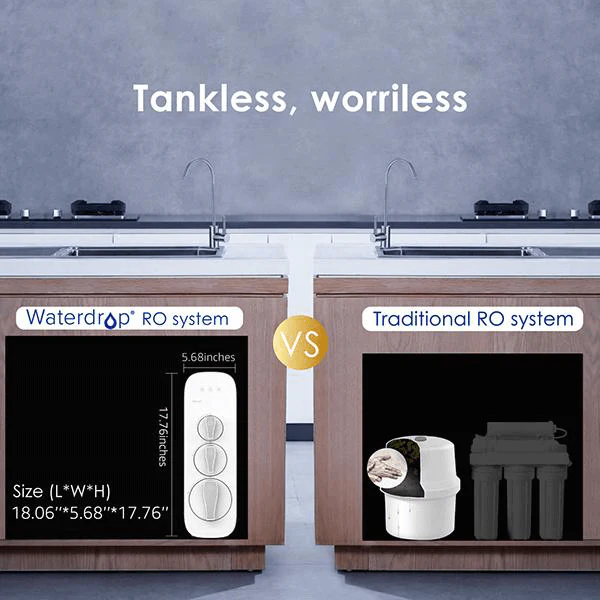The traditional reverse osmosis water filter system filters water and then stores it in a tank ready to be used. But this comes with a few issues. For instance, leaving the tank unflushed or uncleaned for an extended period encourages the growth of bacteria. The system is also more likely to produce water with a foul odor, principally due to the rubber separating the air from the water.
Thankfully, recent technological advancements have solved this problem. We now have a new generation of RO water filter systems without storage tanks. They are called Thankless Reserved Osmosis Systems. These more advanced RO systems are also more efficient, i.e., they produce less wastewater compared with the traditional RO systems with storage tanks.
The Reverse Osmosis System Explained
The municipal water coming into your home comes under high pressure. Reverse osmosis uses this pressure to force water through a semi-permeable membrane, separating the impurities and water molecules on either side of the membrane. Therefore, the water you get from your household tap is clean and free of impurities.
RO systems deliver this high level of filtration thanks to the several filtration stages it puts your tap water through. These may be up to seven in some cases but are generally four;
- The sediment filter separates large particles capable of damaging the RO membrane from the water early.
- The carbon filter offers additional protection by separating chlorine and other contaminants. This leads to a refined water taste and the elimination of foul odors.
- The reverse osmosis membrane is the main stage. This is where all the other contaminants are separated from the water molecules.
- The polishing filter completes the filtration process by removing any contaminants still in the water. It also polishes the odor and taste for the last time.
Why you should choose tankless RO over other water filtration systems
Improved Filtration Performance
The reverse osmosis membrane has numerous pores with a size of about 0.0001 microns. Therefore, it effectively blocks the passage of most contaminants through it, including harmful substances like viruses and bacteria. The filter removes some microelements that may benefit you, including calcium, magnesium, and sodium. What you get in the end are pure water molecules.
Zero Secondary Contamination
As mentioned earlier, the inbuilt tanks in traditional RO systems are flawed. They serve as a viable breeding ground for bacteria when they are not regularly cleaned and flushed. It is even more worrisome when you consider the high cost of cleaning or washing the tank. The container also adds a rubber smell to the filtered water, making it unfit for drinking.
All these issues have been resolved in the new generation of RO water filter systems. These units rely on advanced filtration tech to produce more purified water without needing storage tanks. The absence of a storage tank means no accumulation of bacteria and other impurities. Therefore, they are generally safer and will produce pure, impurity-free drinking water whenever you want.

Easy Installation
Modern RO purification systems also excel in the aspect of installation. The installation process is simple, thanks to the intelligent and user-friendly design. Unlike traditional RO systems that require several hours and intensive effort to install, you can install tankless RO systems yourself without inviting a professional plumber. The complicated tank and composite filters are absent, making the installation a simple task that can be done in 30 minutes.
You also get a free installation guide out of the box, which offers step-to-step instructions on how to install the system.
Faster Water Flow
When choosing a reverse osmosis water filter system, you will see descriptions like 400 GPD and 800 GPD. These represent the total amount of water that the reverse osmosis water filter system can filter in an ideal state. Modern reverse osmosis water filters are designed to meet large demands for water. For example, Waterdrop reverse osmosis water filter system offers a faster flow rate. The Waterdrop G3P800 takes only six seconds to fill up a glass, while the Waterdrop G3 takes 12.

Remineralizing Reverse Osmosis Water
A minor downside of RO water filter systems is that they demineralize water during filtration. This means the filtered water from these systems lacks the necessary microelements. This might be fine for people who supplement their micronutrients through diet.
For other people, there is an option to improve your RO drinking water by remineralizing the water.
Go for a RO system with a remineralize water filter
The most effective and easiest way to take advantage of the mineralized water is to choose a reverse osmosis system with a mineralized filter. The regular RO water filter system has three filtration stages: the PP filter, the activated carbon filter, and the RO membrane. Sometimes, there may be a post-activated carbon filter or a remineralized water filter. In the case of a unit with a remineralize water filter, it adds minerals back into the filtered water and balances the pH before sending it out through the tap.
Include a remineralize water filter in your RO system
Do you have an RO system without a remineralize water filter? Not to worry, you can add a separate remineralize water filter instead of buying another RO water filter system with an inbuilt mineral filter. The Waterdrop remineralization filter WD-MNR35 is designed to work seamlessly with most undersink reverse osmosis water filtration systems out there. It packs up to 18 natural materials that help restore essential micronutrients into your drinking water, including potassium, sodium, magnesium, calcium, and others.
Manually add mineral salt
Alternatively, you can supplement your microelements by adding mineral salt to your drinking water. It is important to note that the common table salt is not suitable for this process. Instead, use Himalayan salt that contains all the essential trace minerals that the reverse osmosis filter removed during filtration. This option is a cost-effective and reliable way to remineralize your filtered water.















































